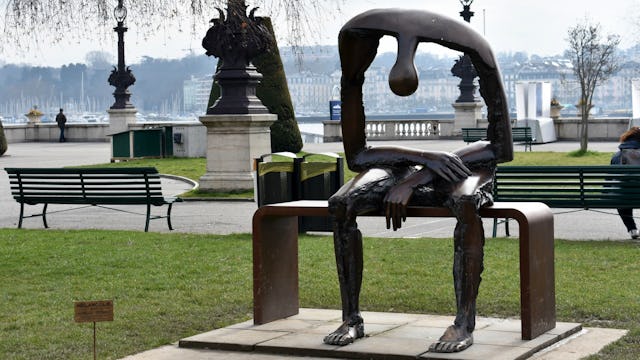Why This Sculpture Perfectly Depicts Grief

If you’ve ever been one among the unlucky, helpless and forced to grieve the loss of a loved one, it’s not unusual to feel like a part of you has just been tragically dismembered. I say tragically because nobody wants to face death, and I say dismembered because, with the death of someone we love, goes bits and pieces of ourselves as well.
I know this all too well. My daughter died from SIDS when she was just four months old, and a part of me will never heal quite right because of it. For me, it felt as if I’d been blasted straight through.
So it’s no wonder that this sculpture is taking grieving hearts by storm. It’s called “Melancolie,” and its screaming accuracy, without the need for any words, is leaving aching souls in awe.
SOURCE UNKNOWN
“Melancolie” resides along the shores of Lake Geneva in Switzerland, and its bold stance on grieving in a world that never stops spinning, is resonating with countless others around the world.
It’s long been said that a picture is worth a thousand words, but what about this breathtaking statue?
The small park chosen to house this work of art displays the true desolation and loneliness associated with grief. It’s gaping hole is the toll of grief — making the individual nothing more than an outward, physical shell to blaze through life without cause. But perhaps it’s the way that the head is slumped down and staring into it’s newly-found crater that’s causing millions to fall awe-stricken with the reality of this sculpture. The way it curves into it’s own sadness and loss, unable to focus on anything but the current state of it’s own despair.
It’s me, and millions of others too.
Everything about “Melancholy” is the depiction of grief. From the location, to the exquisite and intricate meaning behind the copper and tin, mourning hearts of this world have never felt so understood.
I’ll never forget what it was like when the rest of the world expected time to start ticking for me once again, and it was still frozen still. Strangers would see me on the rare outings I would take, and the old men would shout a carefree and unknowing, “Smile, girl!” If only they truly knew the battle I was fighting… but they didn’t. And that’s the thing about grief, it’s a lone road that’s often invisible to the naked and unexperienced eye.
In the post above, this sculpture is thought to be solely for parents grieving the loss of a child. But it vastly exceeds that one interpretation. Perhaps that’s what makes this piece of art so magnificent after all — the fact that it can resonate with so many different people at so many different points in their grief, and it does all of this without morphing into anything other than what it already is.
Romanian artist Albert György sculpted this piece after the loss of his first wife so he is no stranger to the loneliness brought on by grief. His artwork comes from somewhere rich inside the heart, and it definitely shows. In his own reports, he says that after the loss of his first wife, he settled into a haze of isolation and depression. Thankfully, after due time, he found a new lease on life.
A parent in mourning says, “Our core is empty. There is real identity confusion. The essence of who we were is gone. Our souls are deeply wounded… our spirits wander, lost, looking for something to heal us or make us whole again.”
Truth.
György’s sculpture is a valid representation of the toll that grief truly takes — a widened and never-closed hole that we slowly mold, fit and adjust to until we can find a new normal. And while this sculpture does show the devastating effect of grief, it is important to note that this gaping hole is not the essence of grief itself.
Your grief is not a bottomless pit. Grief is a journey, a windy road with no real destinations… just pit stops. I’d like to think that if this sculpture could move through the many stages of grief as we humans do, that it would start to slowly lift it’s head as time moved on. The hole would still be there, blasted through and unscathed, of course. But it would rise and find a new lease on life… just as the artist has done.
This article was originally published on